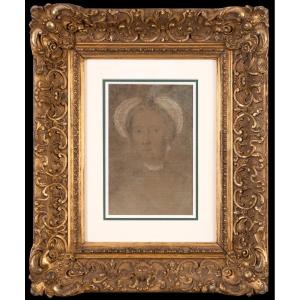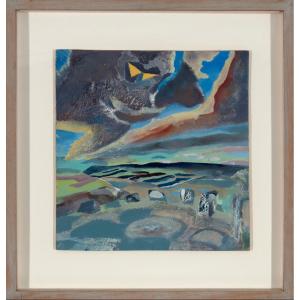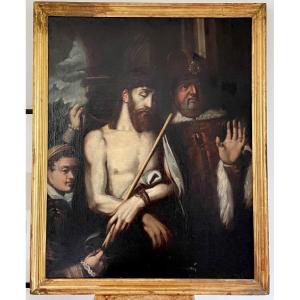Circle of Tomaso D’Antonio Manzuoli, known as Maso da San Friano (1536-1571), After Andrea del Sarto (1486-1531)
The Virgin and Child with the Infant Baptist
Oil on poplar panel
In a 19th century Dutch Metal frame of composite Renaissance design
78.4 x 60 cm.; (within frame) 104.1 x 87.4 cm.
PROVENANCE
By tradition the Convento di San Francesco a Montecarlo, San Giovanni Valdarno;
Acquired by Jeremy Peyton-Jones (d. 1930), of 78 Park Street, Grosvenor Square, London, c. 1920;
Thence by descent until 2024;
Private collection, United Kingdom.
Resting at the base of a tree, the robed Virgin supports the naked Christ Child, who standing with his left hand raised blesses the infant John The Baptist as two attending angels look on. The Virgin appears as a Madonna of Humility, kneeling on one leg and bearing a foot from the folds of her robes. The infant Baptist is clad in a garment of camel tied around the waist with a leather girdle, an attire worn by the adult Baptist in the desert (Matthew 3:4). He holds a primitive cane crucifix in his right hand, raised in acknowledgment of the Virgin. The golden outer rims of two translucent haloes crown the infant Christ and Baptist. The upper right of the panel is populated by colored vegetation, which expands to a rocky landscape beyond under a deep sky. The Christ Child is distinguished by a greater refinement of form, his torso and legs rendered sensitively with an attractive coloring and marvelous fluidity, extending into the robes of the Virgin underfoot. The robes of the Virgin appear somewhat translucent, and the thinner pigment reveals traces of the monochromatic imprimitura below.
The present work derives from a composition by Andrea del Sarto in the Wallace Collection, dating from c. 1517-19 (P9). The Wallace Madonna measures some 10 inches larger in scale, with a broader palette and the inclusion of a scene from the Fioretti di San Francesco, which shows St Francis kneeling before an angel who plays the rape upon a cloud. This variation on scenes of the infant Christ and Baptist proved particularly successful for del Sarto: ‘judging by the large number of copies or versions that were taken from it, this painting must have enjoyed exceptional success […] perhaps in virtue of the particularity of the subject which certainly underlies a coded sacred allegory’ (Natali, p. 72).
The present work is considerably earlier than later copies of the Wallace Madonna, many of which were made on canvas in the 19th century. The present work is on a typically Italianate support of thick poplar wood, with three tapered or ‘dovetailed’ strengthening bars driven alternately to the back within corresponding grooves. However, the work is distinguished from the Wallace Madonna by material and stylistic alterations, such as the inclusion of a modest cane crucifix in the hand of the Baptist. Semi-translucent against the Virgin’s robes, the addition emphasizes the immediately recognizable iconography of the Saint, though may have been inserted by a later hand. Further alterations include the inclusion of a halo above the infant Baptist, and more conspicuously the conversion of the rocky mountainside behind the figures to that of a broad tree trunk. The scene from the Fioretti in del Sarto’s composition is omitted.
Del Sarto operated a productive Florentine workshop with a large number of pupils who studied by copying the master concurrently. His influence was outstanding, and he was for generations one of the most highly copied artists in Florence. Professor Antonio Natali, an author of authoritative studies on the artist, has suggested that the present version was produced by a Florentine painter working in the second half of the 16th century. It was likely completed by an artist belonging to the generation that succeeded del Sarto after his death in 1531, and commissioned by a patron who wished to have something of the master. Natali notes a similarity in hand to Tomaso D’Antonio Manzuoli, known as Maso da San Friano, whose characterful (even impish) treatment of putti is close to that of the attending angels seen here (see Fall of Icarus, Palazzo Vecchio, Florence). A similar stylization is that of Carlo Portelli (d. 1574), San Friano’s teacher. The elegance of the Christ Child’s legs is perhaps more pleasing than the awkward musculature of del Sarto’s own composition, and suggests an artist of considerable competence. The less inspired rendering of the attending angels’ faces might indicate numerous hands at work, perhaps the product of studio collaboration. The work was purportedly in the collection of the Convento di San Francesco a Montecarlo, San Giovanni Valdarno, constructed in the period 1428-1438 some 30 miles outside Florence. The convent once contained important works including Fra Angelico’s masterpiece Annunciation of San Giovanni Valdarno, and Neri di Bicci’s Coronation of the Virgin. A copy of the now-lost altarpiece by del Sarto, The Madonna of Sant’Ambrogio, is said to have hung in the Basilica di Santa Maria delle Grazie, 3 miles from the Convent (Shearman). That the town derives both its name and coat of arms from Saint John the Baptist, the significance of this association is not without bearing on the present work, which depicts the infant Saint.
The work was acquired more recently, perhaps in Scotland in c. 1920, by Jeremy Peyton-Jones, an art dealer specializing in early paintings. The Peyton-Jones family’s important collection included del Sarto’s autograph work The Virgin and Child. An advertisement printed in the September 1931 issue of The Burlington Magazine illustrates the painting alongside Peyton-Jones’ address of 78 Park Street, Grosvenor Square, London. Following the death of her husband, Margaret Peyton-Jones oversaw the acquisition of the masterpiece by the National Gallery of Canada, Ottawa, in 1938. The couple were related to the Grosvenor family through Margaret, a patrilineal great-granddaughter of the 1st Marquess of Westminster. The Grosvenor family owned numerous works by del Sarto and his workshop, and it is possible that the present work might have a further historical relation to the Grosvenors. A number of inscriptions and labels verso record the known provenance of the work. A label to the center of the panel reads, ‘From the Convent of San Giovanni in Val D’Arno’, and another partial label of the same hand, to the lower left of the frame reads, ‘From the Convent of S. Giovanni / in Val […] / Purchased […]’. An old photographic reproduction of the Wallace Madonna is affixed above. A small label of a different hand is inscribed ‘Bowring’ to the bottom center of the frame.
I am grateful to Professor Antonio Natali for his assistance in cataloging the present work, and to Ian Tyers for his expertise in wood analysis.
BIBLIOGRAPHY & FURTHER READING:
Julian Brooks, Denise Allen, and Xavier F. Salomon, Andrea del Sarto: The Renaissance Workshop in Action (Los Angeles: The J. Paul Getty Museum, 2015)
Antonio Natali, and Alessandro Cecchi, Andrea del Sarto: Catalogo Completo (Florence: Cantini, 1989)
Jeremy Peyton-Jones, in The Burlington Magazine, September 1931, vol. 59, No. 342, p. 22
John Shearman, ‘A Lost Altar-Piece by Andrea del Sarto “The Madonna of S. Ambrogio”’, in The Burlington Magazine, June 1961, vol. 103, no. 699, pp. 225-230
John Shearman, Andrea del Sarto, 2 vols. (Oxford: Clarendon Press, 1965)




































 Le Magazine de PROANTIC
Le Magazine de PROANTIC TRÉSORS Magazine
TRÉSORS Magazine Rivista Artiquariato
Rivista Artiquariato